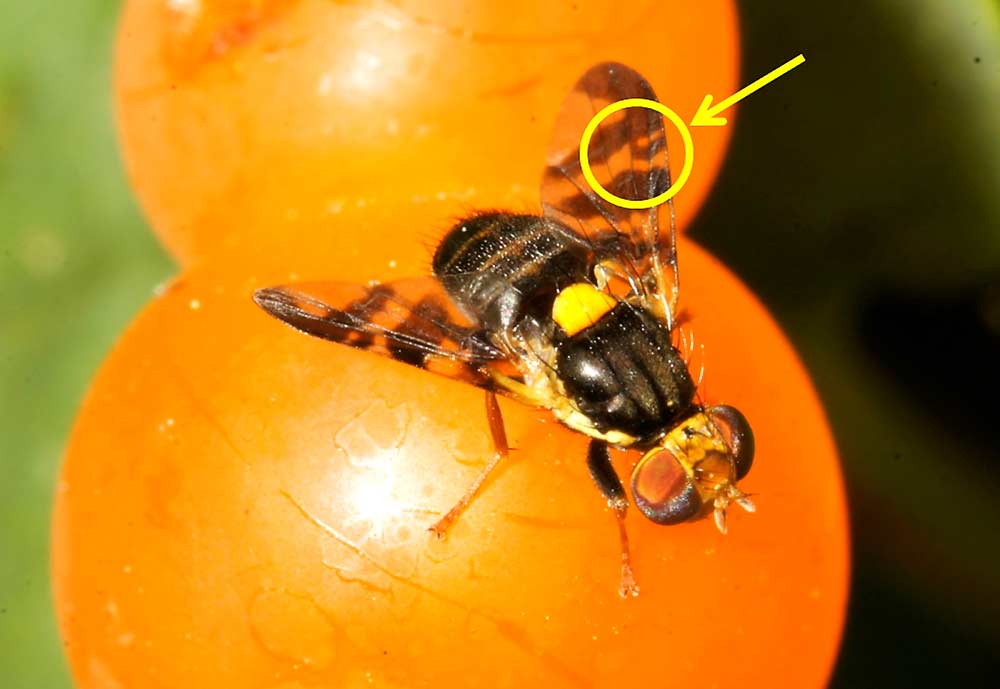UPDATE: U.S. officials have banned the import of fresh cherries from Ontario because the European Cherry Fruit Fly recently detected there “poses a serious threat to United States agriculture.” According to the Animal and Plant Health Inspection Service order issued on May 23, the ban applies to sweet, sour, black, and mahaleb cherries. Fresh cherries from all other Canadian provinces will need to provide proof of origin documents before entering the United States. Canadian regulators are also expected to prohibit the movement of fresh cherries from Ontario to British Columbia, according to the APHIS order. The story below was published in the May 15 issue of the Good Fruit Grower.
There’s a new fruit fly in North America. The European Cherry Fruit Fly, a significant pest of European cherries, was found in an urban park in Mississauga, Ontario, last summer. In response, both Canadian and U.S. regulators say they are increasing surveillance for the regulated pest.

The pattern on the wing of the European Cherry Fruit Fly, Rhagoletis cerasi, can be used to distinguish it from native fruit flies. (Courtesy Steve Paiero,
University of Guelph)
Rhagoletis cerasi is closely related to several cherry fruit flies that are native pests for many U.S. cherry growers. It hasn’t been caught causing any orchard damage, but control measures growers are already using for native cherry fruit flies should be effective against this European cousin, according to the Ontario Fruit newsletter.
That’s likely to be the case in the Pacific Northwest as well, where growers already must contend with the native Western Cherry Fruit Fly, said Mike Willett, manager of the Washington Tree Fruit Research Commission. But without more details about the pest’s life cycle and phenology, it’s hard to know if it could cause new headaches for growers or simply be controlled by existing practices.
However, the pest could pose a serious problem if it makes its way to California. That’s because there are no cherry fruit flies in the San Joaquin Valley, where most of the state’s cherries are grown, said Jay Vanreid, a spokesman of the California Department of Food and Agriculture. An introduced cherry fruit fly could be a significant problem for growers there and for exports, he said.
“Our California cherry growers are the only ones who can ship to South Korea, and a fly like the one found in Canada would be a barrier to that market,” Vanreid said.
The warmer climate in the San Joaquin Valley limits native cherry fruit flies, but it’s unclear if the European fly would have the same climate limits, Willett said.
“We know that it could become established in much of the United States’ cherry-growing regions if introduced, which is part of our basis for considering it a quarantine pest,” said Abbey Powell, a spokeswoman for the USDA Animal and Plant Health Inspection Service in Riverdale, Maryland. “However, the climatic limits for R. cerasi in North America are not yet known.”
It’s also unclear how R. cerasi made its way into Canada. That’s a big concern, Willett said.
Canada requires that cherries imported from Spain be certified free of the fruit fly, but not imports from Turkey, where the pest is also known to occur. If the fly is from a Turkish population and more adapted to warm climates comparable to California, that would be greater cause for concern, Willett said.
The U.S. prohibits all cherry imports from countries where R. cerasi is known to occur, including Turkey and Spain. In 2013, when Turkey sought permission to import cherries, R. cerasi was one of the concerns raised by the tree fruit industry, Willett said.
For now, there’s not much for growers to do but watch and wait.
“Since the Ontario detection, we have increased R. cerasi surveys and will further increase them in 2017 to enhance our ability to detect incursions of this pest,” Powell said. •
– by Kate Prengaman






Leave A Comment